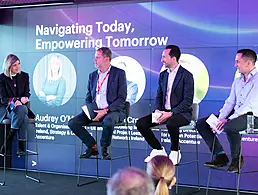Not all fun and games, as VR technologies prove a great help at work too.
Virtual reality (VR) technologies, known mainly as a gaming product, are having an impact on many key industries.
Take for example the healthcare sector where VR tools have been used to train medical students, for virtual less invasive patient examinations and even to increase empathy amongst medical personnel as they can better visualise a patient’s experience.
In the tourism sector, people who may not have the means or the opportunity to travel extensively have the power to take guided tours to far-reaching places from the comfort of their own home. Virtual holidays can include sites such as the Colosseum in Rome and even Mars if you are feeling like a standard trip won’t cut it.
From entertainment and healthcare, to tourism and automation, VR has a boundless sense of potential and that can and should translate to the workforce, but what can employers do to seamlessly and effectively introduce VR technologies into the workplace?
Recruitment
For the majority of people, a job interview is their way of showing their suitability for the role. By discussing the positive aspects of your character and your level of skill you indicate that you are more than ready to take up the position.
But for people applying for a highly technical role, beyond the initial interview, they will have to prove that they have the hard skills needed for the job. VR is a unique and often cost-effective way of testing a candidate’s ability.
By utilising virtual machine models, applicants can be put through various simulations and skills tests, enabling employers to easily identify those who don’t have the necessary skills or training.
You could end up going to a dozen or more skills tests and interviews without ever getting the job, so VR can be a fun and different kind of evaluation that cuts through the mundanity. Additionally, it also ensures that employers aren’t exposing expensive company equipment to accidental damage.
Team building
Whether you run an in-person, hybrid or fully remote workplace, it is crucial that you cultivate a happy, productive and connected space, wherein employees are encouraged to engage with one another.
The workplace is modernising and so too should the team0-building efforts. Team building improves communication and productivity, but perhaps more importantly it generates trust and a sense of camaraderie.
Many of the team-building tricks of the last few decades, for example, trust fall exercises, silent word-based games and ice-breaker questions are effective, however, VR modernises classic team-bonding initiatives and can bring a fun, new element to the workplace.
It can be as simple as everyone logging in and using a headset to sit together and have a coffee in a virtual cafe, or playing a multiplayer game that requires collaboration, communication and critical thinking.
Skills development
The immersive and interactive elements of VR are hugely beneficial for employee training and skills development. For many learners, the immersion into virtual worlds, where you advance through education and personal development, can be a powerful and long-lasting learning experience. Realistic simulations that require ‘hands-on’ activity can improve knowledge retention and will likely keep the trainee’s interest for the entirety of the session.
Also, because VR is open to positive manipulation, users can tailor training modules to their specific development goals and make optimum use of their time.
Another convenient use for VR training systems is in safety courses, wherein you can simulate an unsafe scenario and show the correct form of procedure without risk. For example, if you wanted to show how heavy materials should be correctly lifted, but do not want to encourage people to practise with actual heavy items.
If you are thinking of introducing VR technologies into the workplace the best advice is do your research. Speak to employees about the areas they feel could use some intervention and if it isn’t broken, don’t fix it. VR should make working life easier and hopefully a little bit more interesting.
Just because VR isn’t real life doesn’t mean it can’t have a real-world positive impact on working life.
Find out how emerging tech trends are transforming tomorrow with our new podcast, Future Human: The Series. Listen now on Spotify, on Apple or wherever you get your podcasts.




